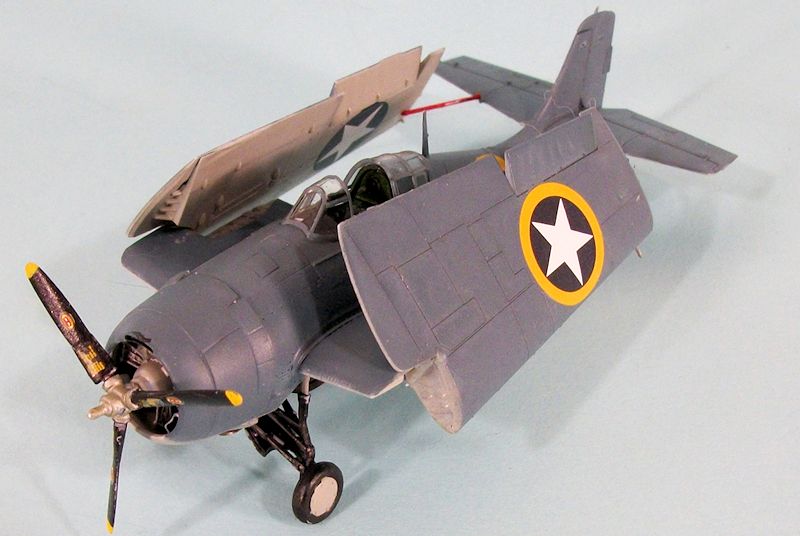
| KIT #: | A02070 |
| PRICE: | $10.99 |
| DECALS: | Two options |
| REVIEWER: | Tom Cleaver |
| NOTES: | New tool kit (2015) |

| HISTORY |
Wildcats Over Casablanca:
VF-9 was formed in the summer of 1942 to become the fighter squadron of the air group that would be assigned to the USS Essex (CV-9) then nearing construction completion. In September 1942, VF-9 was ordered aboard USS Ranger (CV-4) as a second fighter squadron in Air Group 4 to participate in the coming invasion of North Africa, Operation Torch.
The first waves of
American troops hit the beach at Fedala, 15 miles North of Casablanca; Mehdia 70
miles north of Fedala; and Safi,140 miles soutwest of Casablanca, on Sunday,
November 8, 1942. Ranger fighter squadrons VF-9 and VF-41 were assigned to hit
Cazes airfield, a main base of the Vichy French Air
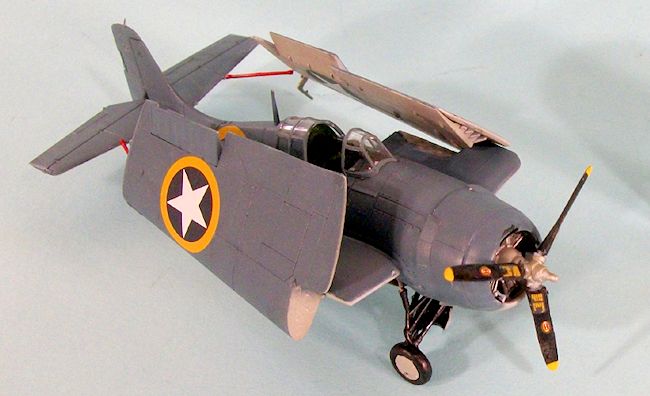 Force. The
French air threat of action had to be clear before American aircraft would be
allowed to enter combat, since it was hoped that direct combat might be avoided.
When the Wildcat pilots saw several aircraft below taking off, LCDR Tommy Booth,
CO of VF 41, called, “Batter up!” In response to the prearranged signal, Ranger
radioed, “Play ball!" The fight was on.
Force. The
French air threat of action had to be clear before American aircraft would be
allowed to enter combat, since it was hoped that direct combat might be avoided.
When the Wildcat pilots saw several aircraft below taking off, LCDR Tommy Booth,
CO of VF 41, called, “Batter up!” In response to the prearranged signal, Ranger
radioed, “Play ball!" The fight was on.
There were two fighter groups at Cazes, equipped with Curtiss Hawk 75As and Dewoitine D.520s. The dogfights were fierce and the Americans found themselves up against an experienced foe. Many French pilots had seen combat against the Luftwaffe during the Battle of France. All the Americans were untested in combat.
LCDR Jack Raby led part of VF 9 to Port Lyautey, where they shot down a twin engine Potez 63. VGF-26 and VGF-27, operating from the escort carrier Santee, also encountered several French fighters and bombers and shot down several. Unfortunately, VGF 27 Wildcats spotted a RAF Hudson, which they had wrongly identified as French and shot down with only one survivor of the four man crew.
LCDR Tom Blackburn of VGF 29 was forced to ditch his Wildcat after running out of gas whiule trying to recover onboard USS Santee in bad weather. Blackburn spent 60 hours in his life raft until a destroyer plucked him from the water.
November 8 was a rough initiation to combat for the Wildcat squadrons, which lost seven F4F-4s to enemy action and 16 to operational causes.
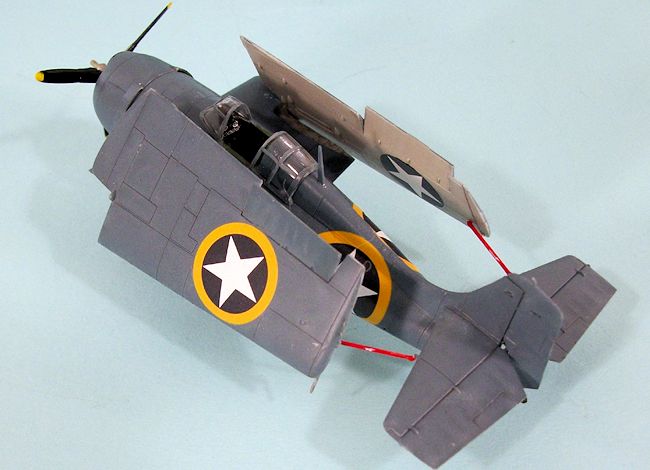 On November
9. Air operations were centered around supporting the Allied troops and putting
to an end whatever French resistance continued. VF 9 Wildcats found 16 Hawk 75s
and shot down five for the loss of one, whose pilot was rescued. VF 9 also lost
3 more Wildcats during strafing missions at Port Lyautey.
On November
9. Air operations were centered around supporting the Allied troops and putting
to an end whatever French resistance continued. VF 9 Wildcats found 16 Hawk 75s
and shot down five for the loss of one, whose pilot was rescued. VF 9 also lost
3 more Wildcats during strafing missions at Port Lyautey.
By the time an armistice was reached on November 11, the Wildcat pilots claimed 22 French aircraft shot down for the loss of five F4Fs in aerial combat (the French admitted to losing 25). Fourteen Wildcats were lost in operational accidents. In total, 23% of all Wildcats in the American carrier force had been lost. Capt C. T. Durgin, Ranger’s CO, visited Cazes on November 12. After meeting with the pilots of his air wing who had been prisoners, he said of the stout defense by the French: “If this battle had continued at the pace of the first day, I would have had to return to the US for replacements.”
VF 9 claimed six victories and four probables in the air, as well as 49 planes destroyed on the ground. VF 9 lost Lt(jg) Stanton M. Amesbury, Lt Edward Micka, and Ens Thomas M. Wilhoite.
Ranger returned to Norfolk, Virginia, in late November. VF-9 was slated to re-equip with the new F4U-1 Corsair, but production deliveries resulted in their becoming the first Navy squadron to equip on the Hellcat. In a deployment aboard Essex from August 1943 to March 1944, VF-9 created the first Hellcat aces, and was the top-scoring Navy unit when they left the ship; their replacements in VF-15 would top that score, as would VF-2, but VF-9 was the only Navy fighter squadron of the war to make three deployments by the end, and to have fought in both the Atlantic and Pacific Theaters.
| THE KIT |
Airfix has been releasing upgrades of old kits. This F4F-4 replaces the FM-2 they released in the late 1960s. Scott Van Aken reviewed what’s in the box last week.
| CONSTRUCTION |
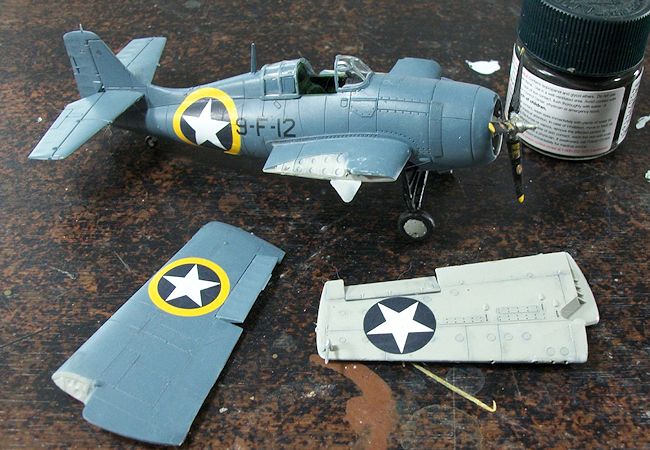 As with
most of the new Airfix releases, overall fit was so good that I did not use
filler anywhere but along the lower fuselage centerline, and that was likely my
own fault for not cleaning up the interior parts completely, which are a tight
fit.
As with
most of the new Airfix releases, overall fit was so good that I did not use
filler anywhere but along the lower fuselage centerline, and that was likely my
own fault for not cleaning up the interior parts completely, which are a tight
fit.
I pre-painted
everything, then assembled the cockpit and landing gear and installed them in
the fuselage. Once that was closed up, I attached the engine and the cowling. I
attached the horizontal stabilizer and the rudder, and the wing center sections,
since I had decided to fold the wings. I assembled the outer wings with the
ailerons both in the raised position they take when the wing is folded.
| COLORS & MARKINGS |
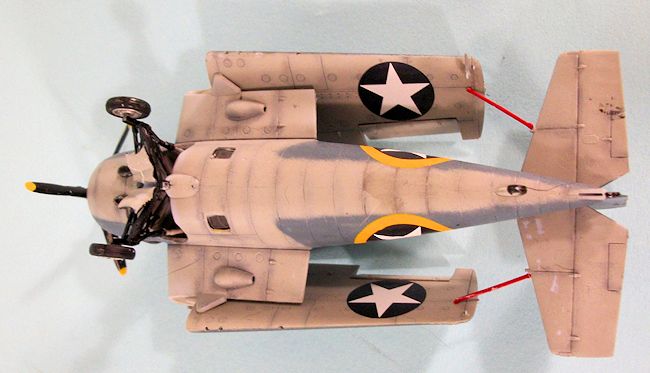 I preshaded
the model, then painted it in Blue-Grey and Light Grey, using Tamiya and Gunze
paints, freehanded.
I preshaded
the model, then painted it in Blue-Grey and Light Grey, using Tamiya and Gunze
paints, freehanded.
I used Yellow Wings Decals for the national insignia and squadron ID, and the kit markings for all stencils. When that was completed, I gave the model an overall coat of Xtracrylix Flat varnish.
I attached the wheels
and prop, and the windscreen, with the canopy in the open position. The wing
attachment is not fully accurate, but it works easily and looks right. I then
attached the stabilizing bars to the wingtips and horizontal stabilizers.
| CONCLUSIONS |
Best. Wildcat. In. This. Scale. The Airfix Wildcat is an easy model to assemble. I think the whole thing took less than 12 hours from start to finish over three days. It looks right, and gives a modeler the choice of folded or extended wings. Highly recommended.
October 2015
Review kit courtesy of my wallet (which it did not harm)
If you would like your product reviewed fairly and fairly quickly, please contact the editor or see other details in the Note to Contributors.